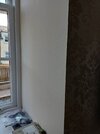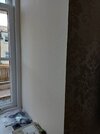Another interesting find in my weird and wacky mill conversion flat. The previous owner took down their tv bracket and I'm just getting round to replacing it. I've just checked the depth of the existing screw holes and they are about 65mm deep before I hit anything solid, which I assume is a stud. It doesn't sound like brick or concrete. Is it possible to have 65mm thick plasterboard? The windows recesses to the side of this wall are incredibly deep (620mm) as shown in the photo. I'm assuming the previous owner's tv didn't fall off the wall and I saw it when viewing the flat, so I'm also assuming that it's safe to put up another bracket using suitably long coach screws.



You are using an out of date browser. It may not display this or other websites correctly.
You should upgrade or use an alternative browser.
You should upgrade or use an alternative browser.
65mm plasterboard. Is this possible?
- Thread starter markjg123
- Start date
Sponsored Links
Would that be like 5 layers of 12.5mm board for example? Why would it be like that with the stud so far back from the wall face?Could it be dot and dab?
I'd suspect internally insulated walls. So wall /studs / plasterboard and insulation between the studs and noggins? 50mm celotex or similar plus a plasterboard and skim?
Anything in the Planning Docs and drawings for the conversion??
What are the outside walls made of?
Anything in the Planning Docs and drawings for the conversion??
What are the outside walls made of?
Sponsored Links
I don't have the planning documents. Possibly with the council or solicitor?I'd suspect internally insulated walls. So wall /studs / plasterboard and insulation between the studs and noggins? 50mm celotex or similar plus a plasterboard and skim?
Anything in the Planning Docs and drawings for the conversion??
What are the outside walls made of?
The external walls are stone. It's a listed building and based on an old Google maps image I suspect all that existed was the outer stone shell and slate roof. I was repairing a wall socket elsewhere in the flat and spotted grey breeze block behind the plasterboard. It made me suspect the internal structure of the flats was built using breeze block with studs and plasterboard on top. Clearly I'm not a builder so that's just an uneducated guess.
With what you've described, does it make sense to find a stud 65mm back from the wall face? I've got a basic stud finder that is detecting screws at 400mm intervals, but I don't know if they are actually going into a stud or just another layer of plasterboard or insulation.
insulated plasterboard ? Comes in 62.5mm dimension .
Could be foam fixed .
Could be foam fixed .
Last edited:
It's probably just insulation + plasterboard, could be insulation between batten + plasterboard, or insulated plasterboard either dot and dabbed on or mechanically fixed, there may also be a waterproof membrane behind the insulation.
Many planning docs are available to download on Council websites (in England) ... but solid stone outer wall would need some sort of added insulation for Building Regs, surely.
Ask other flat owners if they know how those outer walls are constructed?
Corefix dot and dab fixers may be suitable or other similar fixers if you can't find the wood battens to screw to. https://metexonline.com/product-category/fixings/corefix/
Ask other flat owners if they know how those outer walls are constructed?
Corefix dot and dab fixers may be suitable or other similar fixers if you can't find the wood battens to screw to. https://metexonline.com/product-category/fixings/corefix/
Do you have a loft? If so it may be possible to see what the wall lining is made up from up there.
I'm in Scotland. I'll contact the local building control department.Many planning docs are available to download on Council websites (in England) ... but solid stone outer wall would need some sort of added insulation for Building Regs, surely.
Ask other flat owners if they know how those outer walls are constructed?
Corefix dot and dab fixers may be suitable or other similar fixers if you can't find the wood battens to screw to. https://metexonline.com/product-category/fixings/corefix/
No loft I'm afraidDo you have a loft? If so it may be possible to see what the wall lining is made up from up there.
I'm just completely puzzled. I can't be sure it's a stud I'm hitting 65mm in with the screwdriver in the photo, but if it is and 62.5mm insulated plasterboard has been attached to these studs, then what is the studfinder detecting at 400mm intervals on the wall? Could it be screw heads and that's how the insulated plasterboard has been attached to the studs?insulated plasterboard ? Comes in 62.5mm dimension .
Could be foam fixed .
You can use a drill bit to find out, if it's timber it will show up on the end of the bit as wood shavings, same as if it's the back of the wall which will be powdery, the two materials also feel completely different to drill into. You could probably achieve the same by pushing the screwdriver hard into it and giving it a few turns, timber will feel different to masonry which will feel much more solid and again you're likely to see some evidence on the end of the screwdriver. I suspect it's the back of the wall you're feeling. I doubt they would fix studs to the wall and then insulated plasterboard. You could also undo a plug socket or light switch on that wall and see if you can see what's what.
I'm trying to avoid making even more holes in the wall because it's wallpapered. I'll remove a socket first of all and have a look behind it and report back here.You can use a drill bit to find out, if it's timber it will show up on the end of the bit as wood shavings, same as if it's the back of the wall which will be powdery, the two materials also feel completely different to drill into. You could probably achieve the same by pushing the screwdriver hard into it and giving it a few turns, timber will feel different to masonry which will feel much more solid and again you're likely to see some evidence on the end of the screwdriver. I suspect it's the back of the wall you're feeling. I doubt they would fix studs to the wall and then insulated plasterboard. You could also undo a plug socket or light switch on that wall and see if you can see what's what.
DIYnot Local
Staff member
If you need to find a tradesperson to get your job done, please try our local search below, or if you are doing it yourself you can find suppliers local to you.
Select the supplier or trade you require, enter your location to begin your search.
Please select a service and enter a location to continue...
Are you a trade or supplier? You can create your listing free at DIYnot Local
Sponsored Links
Similar threads
- Replies
- 1
- Views
- 2K
B



